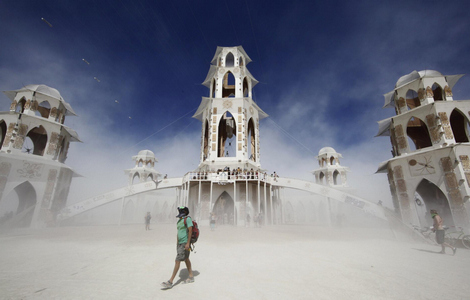Japan disaster drills hold greater sense of urgency
Updated: 2011-09-01 16:58
(Agencies)
|
|||||||||||
|
 Tokyo Metropolitan Police Department officers wearing chemical protective gear take part in an earthquake disaster drill in Tokyo Sept 1, 2011. [Photo/Agencies]
|
The government conducted drills based on the scenario of a 7.3 magnitude earthquake striking Tokyo, which would have catastrophic consequences given that the capital and its surrounding prefectures account for over a quarter of Japan's population and about a third of its economy.
More than a thousand people participated in exercises in central Tokyo's Yoyogi Park, where military helicopters buzzed overhead, police bikes sped past and medical personnel tended to people trapped under a damaged car in a mock emergency situation.
Outgoing Prime Minister Naoto Kan, whose support ratings plummeted due to disapproval of his administration's response to the March disaster, held a mock press conference in which he told the public that the government was doing its utmost to minimise the damage.
"It feels more real, that this place could actually be filled by people unable to get home," said Ikuo Suzuki, an official at Yoyogi Park, which is a designated evacuation area in the event of a major earthquake.
Preparedness exercises included experiencing various disaster situations, such as boarding a specially designed elevator that shakes violently as if in a strong earthquake.
"It has a tenser atmosphere than I expected," said Masako Yoshida, a mother of two who was participating for the first time. "I remembered how on that day (March 11), I was separated from my children. Transport had stopped."
The police also conducted exercises in which they blocked traffic at about 100 locations in Tokyo to practice ensuring the passage of emergency vehicles.
The preparedness drills are held every year on September 1, the anniversary of the Great Kanto Earthquake that killed 140,000 people in the Tokyo area.
The government forecasts that a 7.3 magnitude quake directly under Tokyo would kill up to 11,000 people, injure about 210,000, force 7 million to evacuate and cost the $5 trillion economy around $1 trillion in damages -- five times the estimated damages from the March 11 disaster.
Kishie Shigekawa, a professor of environmental disaster studies at Fuji Tokoha University, said progress has been made in improving Tokyo buildings' anti-quake reinforcements, after the 1995 Kobe earthquake in western Japan took so many lives due to lack of structural strength in that city's buildings.
But she warned that post-quake fires were an urgent issue given Tokyo's dense population and crowded architectural landscape.
"It inevitably takes time, but long-term city planning to reduce loss of life ... is something we need to keep on pushing for," Shigekawa said.
- Authority verifying Conoco oil leak claim
- China-Eurasia Expo opens in Urumqi
- Iceland land deal 'purely commercial'
- Sino-Philippine trade to double
- Conoco's oil leak claim not verified by China
- Hu reaffirms stance on S China Sea
- 'Sabotage attempts' thwarted
- Compensation group set up as spill deadline dawns
Hot Topics
Libya conflict, Gaddafi, Oil spill, Palace Museum scandal, Inflation, Japan's new PM, Trapped miners, Mooncake tax, Weekly photos, Hurricane Irene
Editor's Picks

|

|

|

|

|

|







